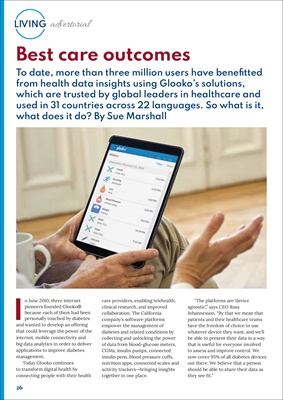
26
LIVING
radio frequency identity) "uses
electromagnetic energy in the form
of radio waves to non-invasively
capture molecular signatures", its
website explains. It has developed
two devices - the pocket-sized
KnowU, which requires the user to
place their palm on a small gadget,
and the UBand, a continuous
monitor worn on the wrist like a
watch. Internal tests showed an
impressive MARD of 6.7% when
compared against finger-stick
monitoring. Know Labs is enrolling
volunteers in clinical trials.
• Occuity Indigo is a small
contactless pen-sized device that
reads glucose levels through the
eye from small, Berkshire-based
medtech start-up Occuity. When
you hold the Occuity Indigo up
to your eye, a small beam of light
is directed at the eyeball and a
glucose reading is obtained thanks
to the light that is sent back to the
device. It is believed that the levels
of glucose found in the aqueous
humour in the eye are similar to
those found in blood. The device
is currently in the research and
development phase.
Non-invasive fluid
sampling
This category of glucose monitoring
has so far proven to be the least
successful, the Google contact lens
being a case in point. There are
concerns that glucose levels in tears,
sweat and saliva might not correlate
with blood glucose levels. The most
promising fluid-sampling device to
date is SugarBEAT from UK company
Nemaura Medical, which uses an
electrical current to draw out a
sample of interstitial fluid. Interstitial
fluid is the fluid measured in CGM
devices and is considered to have
a similar glucose concentration to
blood plasma.
SugarBEAT takes the form of a
skin patch attached to a transmitter,
which then sends readings to a
smartphone. With a MARD of 11.92%
to 12.4%, it has been approved for use
in Europe and the SugarBEAT device
and sensors will soon be available on
prescription in the UK to people with
Type 2 diabetes through Nemaura's
licensee MySugarWatch.
Like CGM and flash technology,
fluid sampling is not strictly
speaking non-invasive, but could be
considered minimally invasive.
A number of companies are at an
early stage with fluid sampling to
measure blood sugar, including Swiss
medtech start-up Nutrix, which aims
to measure glucose levels in saliva
using nanotechnology via its GSense
device, and US-based Graphwear
Technologies' Bios wearable that
also makes use of nanotechnology to
track glucose through sweat. But one
of the most promising developments
is from Dutch firm Novio Sense. Its
monitor measures glucose levels in
tear fluid. One study has shown it
to be close in accuracy to Abbott's
Freestyle Libre. That said, it might
not be to everyone's taste, as it's a
two-centimetre hydrogel-covered
coil containing nanosensors that sits
under the lower eyelid. It uses the
same traditional enzyme technology
as test strips but sends results to a
smartphone. There is, however, no
word yet on how soon it will come
to market.
Improving odds
It's clear that the Holy Grail of truly
non-invasive glucose testing is likely
to remain elusive for some time yet.
But minimally invasive CGM and flash
technology is improving all the time,
offering - for the moment, at least -
better diabetes management, a lower
risk of complications and freedom
from incessant finger-pricking.
Further reading:
Sagejournals.jdst
labiotech.eu
healthline.com
diatribe.org
SugarBEAT patch and watch.